Summer Work
Experiments in high energy physics involve the observation of particles and
their interactions. Many of these experiments involve collider systems, where
beams of particles are accelerated to high energies and forced to interact.
The positions of the particles which come out of the collision are detected
with silicon strip detectors. The detectors we are using are double sided
silicon strip detectors, so they detect particles passing through on both
sides of the detector. On one side of the n-type substrate, highly-doped
p-type strips are implanted; on the other side highly-doped n-type strips are
implanted. These are the different projects SCIPP is working on dealing with
silicon strip detectors:
In an experiment, the signal caused by a particle passing through the detector
can easily be affected by noise generated by the detector or the electronics
used to read out the signal. In this project we measure the noise of silicon
microstrip detectors for different strip lengths and resistances.
For more info, see this page directly.
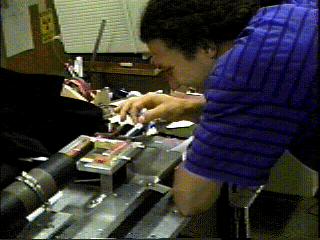 A crucial point for the usefulness of operating silicon detectors at future
colliders is how they will behave in a high radiation environment. The
radiation creates acceptor states in the substrate and a primarily n-type
doped substrate changes into an p-type substrate for high irradiation doses,
called type inversion. Later we may try using an LED light, a more direct way
which penatrates only a few tenths of a micrometer in silicon before it is
absorbed. Therefore, the created electron hole pairs are close to the surface
of the detector, comparing the penetration depth and detector thickness.
These pairs are only collected if the depletion region extends close to the
surface. The aim of this experiment is to measure the detector's response
using beta paticles from a Ruthenium source, and to find out how the response
depends on the irradiation.
A crucial point for the usefulness of operating silicon detectors at future
colliders is how they will behave in a high radiation environment. The
radiation creates acceptor states in the substrate and a primarily n-type
doped substrate changes into an p-type substrate for high irradiation doses,
called type inversion. Later we may try using an LED light, a more direct way
which penatrates only a few tenths of a micrometer in silicon before it is
absorbed. Therefore, the created electron hole pairs are close to the surface
of the detector, comparing the penetration depth and detector thickness.
These pairs are only collected if the depletion region extends close to the
surface. The aim of this experiment is to measure the detector's response
using beta paticles from a Ruthenium source, and to find out how the response
depends on the irradiation.
For more info, see this page directly.
In order to pin-point where a particle (in our case an x-ray) comes through
the detector, we can look for coincidence in space between the two sides of
the detector. In this project we first measure the energy spectrum of various
targets placed in the x-ray beam. We also set up the system so that we can
analyze the coincidence of signals and therefore pick out the true signals
from the noise. We use this to do imaging of differect size slits placed in
front of the x-ray beam. We use two detectors to get a two dimentional (i.e..
x and y direction) mapping of the position of the particle.
For more info, see this page directly.
 The signals caused by a particle passing through a silicon strip detector are
quite small. Therefore, they need to be amplified so that they can be
measured and processed. An essential part of the readout of the electronics
for a silicon strip detector is the analog chip which houses an amplifier. In
this project we test two analog chips that were designed, for different
experiments, by people at SCIPP. We only test the current drawn to find the
bad chips in the batch.
The signals caused by a particle passing through a silicon strip detector are
quite small. Therefore, they need to be amplified so that they can be
measured and processed. An essential part of the readout of the electronics
for a silicon strip detector is the analog chip which houses an amplifier. In
this project we test two analog chips that were designed, for different
experiments, by people at SCIPP. We only test the current drawn to find the
bad chips in the batch.
For more info, see this page directly.
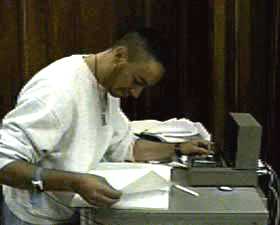
 Transistors are used for low power analog readout for the detectors. We are
using chips with differential pairs of CMOS transistors. Each chip is given
the same fixed drain, source, snd substrate voltage and the drain currents are
measured for different gate voltages. From this, the transconductance (1/R)
and the current mismatch, the difference between the two drain current, is
obtained. We wrote the software used to allow the computer to "talk" to the
parameter analyzer, which takes the data during the tests. We will also be
irradiating the transistors with gamma rays, and retesting and reanalyzing the
data.
Transistors are used for low power analog readout for the detectors. We are
using chips with differential pairs of CMOS transistors. Each chip is given
the same fixed drain, source, snd substrate voltage and the drain currents are
measured for different gate voltages. From this, the transconductance (1/R)
and the current mismatch, the difference between the two drain current, is
obtained. We wrote the software used to allow the computer to "talk" to the
parameter analyzer, which takes the data during the tests. We will also be
irradiating the transistors with gamma rays, and retesting and reanalyzing the
data.
For more info, see this page directly.
We work on two of the current SCIPP projects in particular -- Zeus and ATLAS
. Zeus is nearing its final stages, and for this project we focus on
testing and characterization of completed assemblies, culminating in shipping
of the detectors to Germany in late July. The ATLAS project is in its early
stages, and for this project we work toward an upcoming beam test. For this,
we are testing the continuity on Kapton hybrids, working on the atlas_daq
code, constructing and testing the Cable interface board, and other tasks
needed for constructing and testing for the project.
For more info, see this page directly.
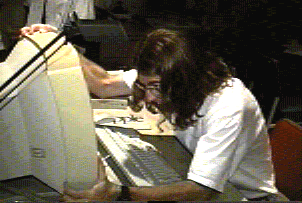
 The ATLAS collaboration working on a silicon tracking detector has proposed a
protocol for serial data transmission of commands from the detector to the
data acquisition system and also for transmission of commands from the control
system to the on-detector electronics. While the proponents of the protocol
believe thay have developed an algorithm for encoding information and marking
information boundaries which can be correctly interpreted by the receiving
circuit, we simulate the transmitting and receiving algorithms to verify their
correctness before the integrated circuits are built. Also, the proposal
makes claims about the protocol's tolerance to transmission errors. We test
this by injecting errors into the simulated data and observing the algorithm's
ability to cope with the errors.
The ATLAS collaboration working on a silicon tracking detector has proposed a
protocol for serial data transmission of commands from the detector to the
data acquisition system and also for transmission of commands from the control
system to the on-detector electronics. While the proponents of the protocol
believe thay have developed an algorithm for encoding information and marking
information boundaries which can be correctly interpreted by the receiving
circuit, we simulate the transmitting and receiving algorithms to verify their
correctness before the integrated circuits are built. Also, the proposal
makes claims about the protocol's tolerance to transmission errors. We test
this by injecting errors into the simulated data and observing the algorithm's
ability to cope with the errors.
For more info, see this page directly.
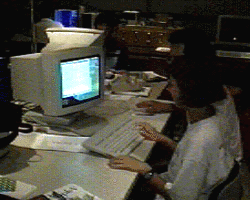 We are setting up a World Wide Web site for SCIPP, both to present activity
happening here for the curious and to share information between active people
of current experiments. We are learning how to write in HTML, how to scan
pictures using PhotoShop, and how to put it all together to create a real
SCIPP site.
We are setting up a World Wide Web site for SCIPP, both to present activity
happening here for the curious and to share information between active people
of current experiments. We are learning how to write in HTML, how to scan
pictures using PhotoShop, and how to put it all together to create a real
SCIPP site.
For more info, see this page directly.
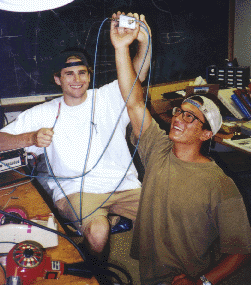 We are currently setting up a new lab to do some maintenance/upgrade work in a
Cerenkov detector which is used to detect Compton-scattered electrons from the
high energy electron beam at the Stanford Linear Accelerator Center. Using
Labview, we set up a data acquisition system which will be used to test and
characterize photomultiplier tubes to be used in the Cerenkov detector. We
also are developing and testing a temperature control system for the
accelerator, allowing us to insulated the detector from the high (>45 degrees
C) ambiant temperature in the Stanford accelerator tunnel. Finally, we do R&D
on a laser/light-fiber calibration system to accurately measure phototube
response linearity and to monitor phototube gain drifts while the detector is
in place in the accelerator tunnel.
We are currently setting up a new lab to do some maintenance/upgrade work in a
Cerenkov detector which is used to detect Compton-scattered electrons from the
high energy electron beam at the Stanford Linear Accelerator Center. Using
Labview, we set up a data acquisition system which will be used to test and
characterize photomultiplier tubes to be used in the Cerenkov detector. We
also are developing and testing a temperature control system for the
accelerator, allowing us to insulated the detector from the high (>45 degrees
C) ambiant temperature in the Stanford accelerator tunnel. Finally, we do R&D
on a laser/light-fiber calibration system to accurately measure phototube
response linearity and to monitor phototube gain drifts while the detector is
in place in the accelerator tunnel.
For more info, see this page directly.
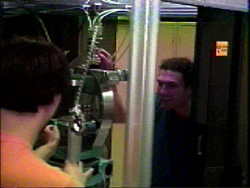 Two major causes of death among adults in industrialized nations are
atherosclerosis (hardening of the arteries) and lung cancer. Both of these
ailments are treatable if detected early in the progress of the disease, but
are often fatal if not. Currently, there are no available non-invasive
diagnostic procedures, but we have developed a diagnostic method that shows
great promise in the diagnosis of these two diseases. Both involve the use of
synchrotron radiation, a highly collimated beam of x-rays emerging from
electron storage rings that can be focused and rendered monochromatic by
careful choice of optical components. In this project, we test a new concept
in x-ray monochromators that utilize the concept of Bragg reflection from
perfect crystals of silicon to achieve highly collimated, intense,
monochromatic beams. Soon some human trials will be conducted at Brookhaven
National Laboratories in New York.
Two major causes of death among adults in industrialized nations are
atherosclerosis (hardening of the arteries) and lung cancer. Both of these
ailments are treatable if detected early in the progress of the disease, but
are often fatal if not. Currently, there are no available non-invasive
diagnostic procedures, but we have developed a diagnostic method that shows
great promise in the diagnosis of these two diseases. Both involve the use of
synchrotron radiation, a highly collimated beam of x-rays emerging from
electron storage rings that can be focused and rendered monochromatic by
careful choice of optical components. In this project, we test a new concept
in x-ray monochromators that utilize the concept of Bragg reflection from
perfect crystals of silicon to achieve highly collimated, intense,
monochromatic beams. Soon some human trials will be conducted at Brookhaven
National Laboratories in New York.
For more info, see this page directly.
 This project was begun last year as one of a number of studies connected with
a proposal to NASA to use silicon strip detectors in a next-generation
orbiting gamma-ray pair-conversion telescope. The detectors will have wide
pitch (300 microns) and narrow strips (30 microns). The use of narrow strips
in the detectors would result in a considerable savings in electrical power.
In such a device the detectors would be placed between thin sheets of lead,
which would serve to convert incident gamma rays into electron-positron
pairs. The silicon detectors would then measure the trajectories of the
electrons and positrons to reconstruct the direction of the incident photon.
We are concerned that these types of detectors might have poor charge
collection from tracks which pass midway between the strips. We are making
more measurements to verify this possible result. We have been getting
inconsistent results, varying from one day to another when using a fast
amplifier. So far the use of a slow amplifier has never shown loss of signal
in the interstrip region. Further data is being taken to investigate these
results.
This project was begun last year as one of a number of studies connected with
a proposal to NASA to use silicon strip detectors in a next-generation
orbiting gamma-ray pair-conversion telescope. The detectors will have wide
pitch (300 microns) and narrow strips (30 microns). The use of narrow strips
in the detectors would result in a considerable savings in electrical power.
In such a device the detectors would be placed between thin sheets of lead,
which would serve to convert incident gamma rays into electron-positron
pairs. The silicon detectors would then measure the trajectories of the
electrons and positrons to reconstruct the direction of the incident photon.
We are concerned that these types of detectors might have poor charge
collection from tracks which pass midway between the strips. We are making
more measurements to verify this possible result. We have been getting
inconsistent results, varying from one day to another when using a fast
amplifier. So far the use of a slow amplifier has never shown loss of signal
in the interstrip region. Further data is being taken to investigate these
results.
For more info, see this page directly.
 There's no place like home!
There's no place like home!
 A crucial point for the usefulness of operating silicon detectors at future
colliders is how they will behave in a high radiation environment. The
radiation creates acceptor states in the substrate and a primarily n-type
doped substrate changes into an p-type substrate for high irradiation doses,
called type inversion. Later we may try using an LED light, a more direct way
which penatrates only a few tenths of a micrometer in silicon before it is
absorbed. Therefore, the created electron hole pairs are close to the surface
of the detector, comparing the penetration depth and detector thickness.
These pairs are only collected if the depletion region extends close to the
surface. The aim of this experiment is to measure the detector's response
using beta paticles from a Ruthenium source, and to find out how the response
depends on the irradiation.
A crucial point for the usefulness of operating silicon detectors at future
colliders is how they will behave in a high radiation environment. The
radiation creates acceptor states in the substrate and a primarily n-type
doped substrate changes into an p-type substrate for high irradiation doses,
called type inversion. Later we may try using an LED light, a more direct way
which penatrates only a few tenths of a micrometer in silicon before it is
absorbed. Therefore, the created electron hole pairs are close to the surface
of the detector, comparing the penetration depth and detector thickness.
These pairs are only collected if the depletion region extends close to the
surface. The aim of this experiment is to measure the detector's response
using beta paticles from a Ruthenium source, and to find out how the response
depends on the irradiation. The signals caused by a particle passing through a silicon strip detector are
quite small. Therefore, they need to be amplified so that they can be
measured and processed. An essential part of the readout of the electronics
for a silicon strip detector is the analog chip which houses an amplifier. In
this project we test two analog chips that were designed, for different
experiments, by people at SCIPP. We only test the current drawn to find the
bad chips in the batch.
The signals caused by a particle passing through a silicon strip detector are
quite small. Therefore, they need to be amplified so that they can be
measured and processed. An essential part of the readout of the electronics
for a silicon strip detector is the analog chip which houses an amplifier. In
this project we test two analog chips that were designed, for different
experiments, by people at SCIPP. We only test the current drawn to find the
bad chips in the batch.
 Transistors are used for low power analog readout for the detectors. We are
using chips with differential pairs of CMOS transistors. Each chip is given
the same fixed drain, source, snd substrate voltage and the drain currents are
measured for different gate voltages. From this, the transconductance (1/R)
and the current mismatch, the difference between the two drain current, is
obtained. We wrote the software used to allow the computer to "talk" to the
parameter analyzer, which takes the data during the tests. We will also be
irradiating the transistors with gamma rays, and retesting and reanalyzing the
data.
Transistors are used for low power analog readout for the detectors. We are
using chips with differential pairs of CMOS transistors. Each chip is given
the same fixed drain, source, snd substrate voltage and the drain currents are
measured for different gate voltages. From this, the transconductance (1/R)
and the current mismatch, the difference between the two drain current, is
obtained. We wrote the software used to allow the computer to "talk" to the
parameter analyzer, which takes the data during the tests. We will also be
irradiating the transistors with gamma rays, and retesting and reanalyzing the
data.
 The ATLAS collaboration working on a silicon tracking detector has proposed a
protocol for serial data transmission of commands from the detector to the
data acquisition system and also for transmission of commands from the control
system to the on-detector electronics. While the proponents of the protocol
believe thay have developed an algorithm for encoding information and marking
information boundaries which can be correctly interpreted by the receiving
circuit, we simulate the transmitting and receiving algorithms to verify their
correctness before the integrated circuits are built. Also, the proposal
makes claims about the protocol's tolerance to transmission errors. We test
this by injecting errors into the simulated data and observing the algorithm's
ability to cope with the errors.
The ATLAS collaboration working on a silicon tracking detector has proposed a
protocol for serial data transmission of commands from the detector to the
data acquisition system and also for transmission of commands from the control
system to the on-detector electronics. While the proponents of the protocol
believe thay have developed an algorithm for encoding information and marking
information boundaries which can be correctly interpreted by the receiving
circuit, we simulate the transmitting and receiving algorithms to verify their
correctness before the integrated circuits are built. Also, the proposal
makes claims about the protocol's tolerance to transmission errors. We test
this by injecting errors into the simulated data and observing the algorithm's
ability to cope with the errors. We are setting up a World Wide Web site for SCIPP, both to present activity
happening here for the curious and to share information between active people
of current experiments. We are learning how to write in HTML, how to scan
pictures using PhotoShop, and how to put it all together to create a real
SCIPP site.
We are setting up a World Wide Web site for SCIPP, both to present activity
happening here for the curious and to share information between active people
of current experiments. We are learning how to write in HTML, how to scan
pictures using PhotoShop, and how to put it all together to create a real
SCIPP site.  We are currently setting up a new lab to do some maintenance/upgrade work in a
Cerenkov detector which is used to detect Compton-scattered electrons from the
high energy electron beam at the Stanford Linear Accelerator Center. Using
Labview, we set up a data acquisition system which will be used to test and
characterize photomultiplier tubes to be used in the Cerenkov detector. We
also are developing and testing a temperature control system for the
accelerator, allowing us to insulated the detector from the high (>45 degrees
C) ambiant temperature in the Stanford accelerator tunnel. Finally, we do R&D
on a laser/light-fiber calibration system to accurately measure phototube
response linearity and to monitor phototube gain drifts while the detector is
in place in the accelerator tunnel.
We are currently setting up a new lab to do some maintenance/upgrade work in a
Cerenkov detector which is used to detect Compton-scattered electrons from the
high energy electron beam at the Stanford Linear Accelerator Center. Using
Labview, we set up a data acquisition system which will be used to test and
characterize photomultiplier tubes to be used in the Cerenkov detector. We
also are developing and testing a temperature control system for the
accelerator, allowing us to insulated the detector from the high (>45 degrees
C) ambiant temperature in the Stanford accelerator tunnel. Finally, we do R&D
on a laser/light-fiber calibration system to accurately measure phototube
response linearity and to monitor phototube gain drifts while the detector is
in place in the accelerator tunnel. Two major causes of death among adults in industrialized nations are
atherosclerosis (hardening of the arteries) and lung cancer. Both of these
ailments are treatable if detected early in the progress of the disease, but
are often fatal if not. Currently, there are no available non-invasive
diagnostic procedures, but we have developed a diagnostic method that shows
great promise in the diagnosis of these two diseases. Both involve the use of
synchrotron radiation, a highly collimated beam of x-rays emerging from
electron storage rings that can be focused and rendered monochromatic by
careful choice of optical components. In this project, we test a new concept
in x-ray monochromators that utilize the concept of Bragg reflection from
perfect crystals of silicon to achieve highly collimated, intense,
monochromatic beams. Soon some human trials will be conducted at Brookhaven
National Laboratories in New York.
Two major causes of death among adults in industrialized nations are
atherosclerosis (hardening of the arteries) and lung cancer. Both of these
ailments are treatable if detected early in the progress of the disease, but
are often fatal if not. Currently, there are no available non-invasive
diagnostic procedures, but we have developed a diagnostic method that shows
great promise in the diagnosis of these two diseases. Both involve the use of
synchrotron radiation, a highly collimated beam of x-rays emerging from
electron storage rings that can be focused and rendered monochromatic by
careful choice of optical components. In this project, we test a new concept
in x-ray monochromators that utilize the concept of Bragg reflection from
perfect crystals of silicon to achieve highly collimated, intense,
monochromatic beams. Soon some human trials will be conducted at Brookhaven
National Laboratories in New York. This project was begun last year as one of a number of studies connected with
a proposal to NASA to use silicon strip detectors in a next-generation
orbiting gamma-ray pair-conversion telescope. The detectors will have wide
pitch (300 microns) and narrow strips (30 microns). The use of narrow strips
in the detectors would result in a considerable savings in electrical power.
In such a device the detectors would be placed between thin sheets of lead,
which would serve to convert incident gamma rays into electron-positron
pairs. The silicon detectors would then measure the trajectories of the
electrons and positrons to reconstruct the direction of the incident photon.
We are concerned that these types of detectors might have poor charge
collection from tracks which pass midway between the strips. We are making
more measurements to verify this possible result. We have been getting
inconsistent results, varying from one day to another when using a fast
amplifier. So far the use of a slow amplifier has never shown loss of signal
in the interstrip region. Further data is being taken to investigate these
results.
This project was begun last year as one of a number of studies connected with
a proposal to NASA to use silicon strip detectors in a next-generation
orbiting gamma-ray pair-conversion telescope. The detectors will have wide
pitch (300 microns) and narrow strips (30 microns). The use of narrow strips
in the detectors would result in a considerable savings in electrical power.
In such a device the detectors would be placed between thin sheets of lead,
which would serve to convert incident gamma rays into electron-positron
pairs. The silicon detectors would then measure the trajectories of the
electrons and positrons to reconstruct the direction of the incident photon.
We are concerned that these types of detectors might have poor charge
collection from tracks which pass midway between the strips. We are making
more measurements to verify this possible result. We have been getting
inconsistent results, varying from one day to another when using a fast
amplifier. So far the use of a slow amplifier has never shown loss of signal
in the interstrip region. Further data is being taken to investigate these
results.